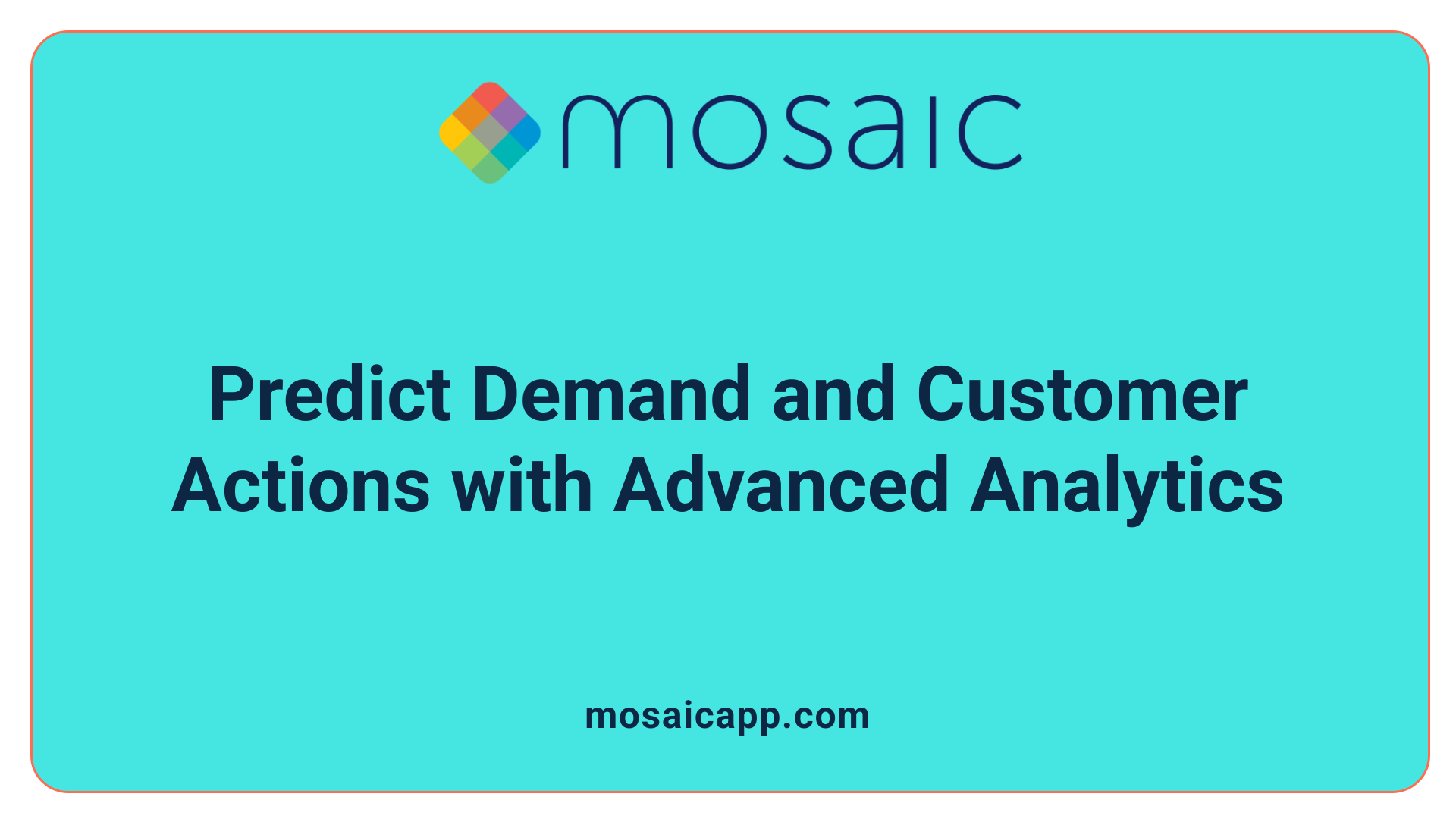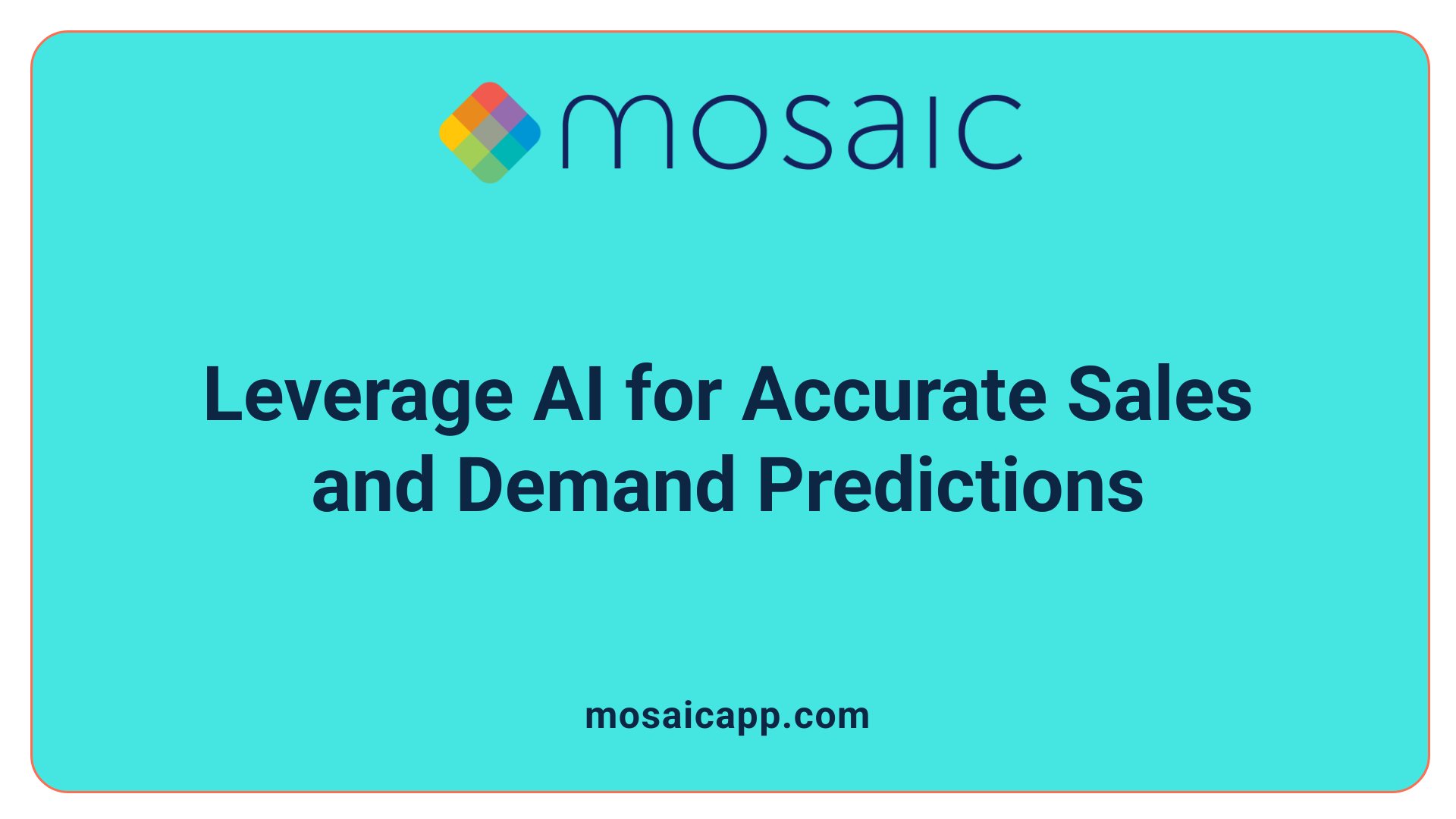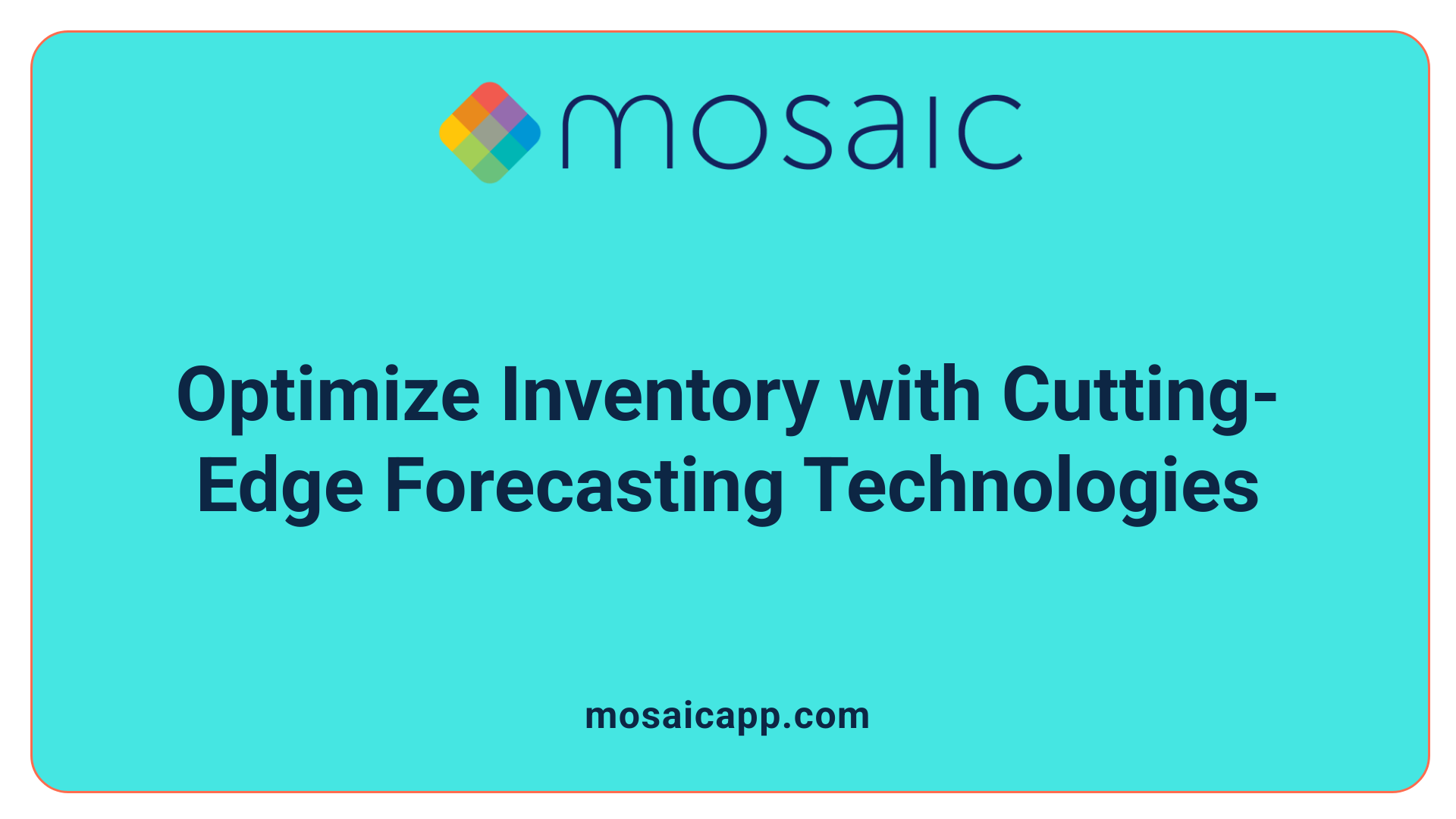The Evolution of Demand Forecasting in Customer-Centric Business Models
In today's fast-paced, data-driven world, businesses are increasingly turning to smarter forecasting methods to not only predict demand but also to enhance customer satisfaction. The integration of AI, machine learning, and comprehensive predictive analytics is transforming traditional demand planning and sales forecasting into proactive, customer-focused strategies. This article explores how these advanced techniques improve operational efficiency, enable personalized customer experiences, and foster loyalty through precise demand prediction and effective resource allocation.
Understanding Smarter Forecasting and Its Impact on Customer Satisfaction

What is smarter forecasting and how does it improve client satisfaction?
Smarter forecasting, especially in demand planning, leverages advanced technologies like AI and machine learning to predict customer demand more accurately. By analyzing various data sources such as sales history, market trends, weather, and social media signals, businesses can refine their forecasts better than traditional methods.
This approach helps companies optimize their inventory levels, reducing both overstock and stockouts. When products are available as needed, customers experience fewer delays and shortages, significantly boosting satisfaction.
Moreover, smarter forecasting enables proactive supply chain management and personalized marketing efforts. With precise predictions, businesses can set better prices, customize offers, and respond quickly to market shifts.
The overall benefit is a smoother customer journey that builds trust. Operationally, this method increases efficiency, reduces costs, and enhances the overall customer experience, fostering loyalty and retention.
Leveraging Predictive Analytics to Anticipate Demand and Customer Behavior

How can predictive analytics be used to forecast demand and customer behavior?
Predictive analytics plays a crucial role in estimating future demand and understanding customer actions. It involves analyzing historical sales data, market trends, and external influences like weather conditions or economic shifts. By utilizing sophisticated machine learning models, including deep learning techniques such as Recurrent Neural Networks (RNNs) and Long Short-Term Memory (LSTM) networks, businesses can identify complex patterns and seasonal fluctuations.
These models help forecast demand with high accuracy, enabling companies to optimize their inventory levels, tailor pricing strategies, and plan supply chain logistics more effectively. Beyond demand, predictive analytics also uncovers customer preferences and behavior patterns, leading to better personalization, increased customer satisfaction, and boosted loyalty. The overall benefit is a proactive approach that guides strategic decisions, minimizes risks, and streamlines operations across various sectors.
What types of data are used in predictive analytics?
Predictive analytics relies on diverse data sources to generate meaningful insights. The most common include:
| Data Type | Description | Example Uses |
|---|---|---|
| Transaction Data | Records of past customer purchases | Identifying buying patterns and product preferences |
| Behavioral Data | Customer interactions on digital platforms | Tracking clicks, page views, and engagement levels |
| Feedback Data | Customer reviews, surveys, and feedback forms | Gaining insights into customer satisfaction and sentiment |
| External Data | Market trends, weather, economic indicators | Adjusting forecasts based on outside influences |
By integrating these different data streams, organizations can create a comprehensive view of customer behavior and market dynamics, leading to more accurate predictions.
What are the benefits of predictive insights for customer engagement?
Using predictive analytics provides multiple advantages that enhance customer relationships. These benefits include:
- Personalization: Delivering tailored marketing messages, recommendations, and offers based on individual preferences.
- Proactive Service: Anticipating customer needs and addressing potential issues like churn signals early, allowing for timely intervention.
- Increased Loyalty: Building trust through relevant communications and improving overall customer experience.
- Operational Efficiency: Optimizing inventory, reducing waste, and ensuring product availability aligns with expected demand.
- Business Growth: Increasing revenue through targeted upselling, cross-selling, and customer retention strategies.
Platforms such as Sprinklr provide real-time, comprehensive consumer insights that help companies make smarter, data-driven decisions, ultimately fostering stronger customer connections.
The Role of AI-Driven Methods in Sales and Demand Forecasting

What are AI-driven sales and demand forecasting methods?
AI-driven sales and demand forecasting methods incorporate advanced technologies such as machine learning algorithms, predictive analytics, and natural language processing (NLP). These tools analyze vast amounts of data, including historical sales figures, customer interactions, and market signals, to generate accurate, real-time predictions of future demand and revenue.
By identifying complex patterns and emerging trends, AI helps businesses assess deal probabilities, anticipate customer needs, and prioritize high-converting opportunities. Common algorithms used include regression models, neural networks, and support vector machines, which are capable of adapting to changing data landscapes and market conditions.
Implementing these approaches involves collecting relevant data, training the models, and continuously monitoring and refining predictions. AI-enhanced forecasting supports improved sales pipeline management, personalized sales strategies, and resource allocation, enabling companies to respond swiftly to market developments and maintain a competitive edge.
Enhancing Inventory Management with Advanced Forecasting Techniques

How can advanced forecasting techniques improve inventory management and operational efficiency?
Modern inventory management benefits greatly from sophisticated forecasting methods like machine learning, time series analysis, and hybrid models. These approaches analyze vast amounts of data, including past sales, seasonal patterns, market trends, and external factors, to produce highly accurate demand forecasts.
Machine learning models, such as neural networks and support vector machines, excel at identifying complex data patterns that traditional models might miss. They continuously refine their predictions based on new data inputs, leading to improved accuracy over time.
Accurate demand predictions enable businesses to optimize their stock levels, minimizing the risk of stockouts or excess inventory. This not only reduces storage costs but also enhances customer satisfaction through more reliable product availability.
Real-time data integration allows companies to react swiftly to market fluctuations and shifting consumer preferences. For example, if a sudden trend emerges, the system can adjust forecasts instantly, informing procurement and inventory decisions.
Advanced forecasting tools also help identify potential disruptions or market wild cards in advance. This proactive insight allows organizations to adapt their strategies early, maintaining supply chain resilience.
Overall, employing these advanced techniques results in cost savings, streamlined operations, and a stronger ability to meet customer demands efficiently.
Strategic Use of Forecasting to Meet Client Expectations

How can companies leverage forecasting tools to turn client expectations into satisfaction?
To effectively meet and exceed client expectations, organizations should adopt smarter forecasting methods like predictive analytics and demand forecasting. These advanced tools help businesses to anticipate customer needs with greater accuracy, allowing for proactive problem-solving before issues arise.
By analyzing patterns in customer data—such as preferences, purchase history, and engagement signals—companies can personalize interactions. This personalized approach enhances the customer experience, as clients receive tailored recommendations and targeted retention efforts, making them feel valued and understood.
Incorporating advanced predictive models into operational workflows enables real-time decision-making. Businesses can adjust staffing levels during peak hours, manage inventory effectively, and optimize service delivery, thereby reducing wait times and improving overall quality.
Furthermore, these forecasting strategies facilitate communication across departments, ensuring that sales, customer service, and supply chain teams work together seamlessly to fulfill client needs.
In summary, leveraging sophisticated forecasting tools empowers companies to anticipate client expectations accurately and respond in a way that fosters satisfaction and loyalty.
| Strategy Aspect | Implementation Details | Benefits |
|---|---|---|
| Data Analysis | Analyze customer preferences, purchase patterns, and engagement signals | Personalization and targeted retention efforts |
| Real-Time Decision-Making | Use predictive models integrated into operational systems | Improve service, reduce delays, manage resources better |
| Cross-Department Collaboration | Share insights across sales, service, and supply chain teams | Cohesive customer experience |
Focusing on smarter forecasting tools enhances customer satisfaction by aligning services precisely with expectations, ultimately building long-term loyalty and trust.
Evaluating and Selecting Demand Forecasting Solutions Effectively
How should businesses evaluate and choose demand forecasting solutions and services?
Choosing the right demand forecasting tools is crucial for accurate planning and operational efficiency. Businesses need to evaluate solutions based on their specific goals, the nature of their data, and industry requirements. They should look for features that support various forecasting methods, such as qualitative insights, time-series analysis, causal models, and machine learning capabilities.
Compatibility with existing systems is also vital. The solution must integrate seamlessly with current ERP, CRM, or e-commerce platforms to ensure smooth data flow and real-time updates. Additionally, the transparency of algorithms—knowing how forecasts are generated—is important for trust and validation.
Validation of forecast accuracy should be an ongoing process. The chosen platform must allow for continuous monitoring and adjustment, accounting for external factors like market trends, seasonality, or economic shifts. Engaging cross-functional teams—such as sales, marketing, and supply chain managers—in the evaluation process helps verify that the forecast aligns with business realities and strategic goals.
Ultimately, the best demand forecasting solutions balance advanced analytics with user-friendly interfaces. They should be scalable and adaptable, supporting the company’s growth and evolving market conditions. Companies that carefully assess these criteria lay the groundwork for more reliable forecasts and better inventory and resource management.
Compatibility with existing systems
An effective demand forecasting solution should integrate with core business systems like inventory management, ERP, and sales platforms. This ensures data consistency and reduces manual input errors.
Validation of forecast accuracy
Forecasts need regular validation against actual outcomes. Solutions offering performance metrics and scenario testing enable teams to refine models, improving prediction reliability over time.
Best Practices for Demand Planning and Business Outcomes
How can organizations effectively integrate forecasting methods?
Combining different approaches to demand forecasting is essential for accuracy and reliability. Quantitative methods like time series analysis, regression models, and machine learning algorithms analyze historical data to generate forecasts. Alongside these, qualitative techniques such as expert opinions, market research, and sales team input help capture market nuances.
An effective demand planning process involves merging these methods, allowing for cross-validation and more comprehensive insights. Using automated systems like Inventory Planner or BigTime can facilitate this integration by analyzing large data sets, recognizing patterns, and updating forecasts in real time.
What role does external data play in demand prediction?
Incorporating external factors enriches demand forecasts. Economic indicators, weather data, social media trends, and competitor activities influence customer purchasing patterns.
For example, a sudden drop in consumer confidence due to economic shifts might reduce demand, while weather forecasts can impact seasonal buying. By feeding these external signals into forecasting models, businesses can anticipate market fluctuations and adapt strategies proactively.
How important is a structured forecasting process?
A disciplined and repeatable process helps organizations respond swiftly to market changes. Establishing a regular forecasting cadence—monthly, quarterly, or aligned with market cycles—ensures forecasts remain current and accurate.
Segmenting demand by product lines, geographical regions, and customer segments allows for targeted planning. Clear roles and responsibilities across departments—sales, marketing, supply chain—improve collaboration and implementation.
Developing contingency plans based on different forecast scenarios enhances resilience. Using advanced analytics and AI ensures continuous improvement as models learn from new data, supporting better decision-making.
| Aspect | Strategy/Tools | Expected Outcome |
|---|---|---|
| Integration of forecasting methods | Machine learning, combined with expert input | More accurate, validated forecasts |
| Use of external data | Economic indicators, weather patterns, social media insights | Market-sensitive predictions |
| Structured process | Regular update schedule, demand segmentation, cross-departmental reviews | Agility, responsiveness, inventory optimization |
Implementing these practices leads to healthier supply chains, cost savings, and improved customer satisfaction. An aligned, data-driven approach ensures businesses can meet customer demand efficiently and adapt swiftly to market dynamics.
The Future of Smarter Forecasting and Customer Success
What are emerging trends shaping smarter forecasting?
The landscape of demand planning, customer behavior prediction, and sales forecasting is evolving rapidly. Advances in machine learning, automation, and real-time analytics are making forecasts more accurate and responsive.
One significant trend is the integration of AI-powered systems like BigTime and Inventory Planner, which analyze extensive data sets to refine forecasts while adapting quickly to market changes. These systems leverage historical data, seasonal patterns, and external market signals to generate precise demand estimates.
Another trend is the focus on end-to-end automation, enabling businesses to act swiftly on predictive insights without human delays. This includes automated replenishment, inventory adjustments, and resource planning based on continuous data streams.
Furthermore, real-time data collection through multiple channels allows organizations to respond dynamically to shifts in customer sentiment and behavior, helping prevent issues like stock shortages or customer churn.
How do AI and data analytics influence future customer management?
AI and analytics are central to transforming how organizations understand and engage customers. By analyzing behavior patterns, feedback, and interaction data—like clicks, scrolls, and session patterns—platforms such as Fullstory can generate predictive insights for individual customers.
These insights facilitate hyper-personalization in marketing, service offers, and engagement strategies. AI models like neural networks, regression, and clustering are used to forecast customer lifetime value, identify churn risks, and pinpoint growth opportunities.
Additionally, AI supports pipeline management by identifying high-potential leads, prioritizing sales efforts, and improving forecast reliability. This results in increased sales velocity and more predictable revenue streams.
In what ways are these advancements transforming the customer experience?
Smarter forecasting enables businesses to deliver personalized experiences at unprecedented scales. For example, predictive behavior modeling can suggest tailored product recommendations or proactive outreach, reducing friction in the customer journey.
With improved demand forecasting and inventory management, companies can ensure product availability aligns with customer expectations, reducing frustrations caused by stockouts or delays.
Furthermore, leveraging real-time insights allows for dynamic adjustments to marketing and service strategies, fostering stronger customer loyalty and satisfaction. Companies that adopt these emerging trends will be better equipped to anticipate customer needs, offer relevant solutions swiftly, and build long-term trust.
| Trend | Impact | Example |
|---|---|---|
| AI-powered forecasting systems | Increased accuracy and responsiveness | Inventory Planner automates replenishments based on forecasts |
| Real-time data analytics | Swift adaptation to changing customer behavior | Fullstory predicts future customer actions from interaction data |
| Automation in decision-making | Efficient operations and resource planning | Demand planning platforms adjusting stock levels automatically |
| Personalization at scale | Better customer engagement and satisfaction | Tailored marketing campaigns based on behavior patterns |
How can organizations prepare for the future of smarter forecasting and customer satisfaction?
Organizations should invest in emerging technologies such as AI, machine learning, and real-time data analytics. Developing solid data governance frameworks ensures responsible data handling, privacy compliance, and trust.
Fostering a culture of continuous learning and innovation is essential. Companies need to integrate diverse data sources for comprehensive insights and upgrade their predictive models with the latest algorithms.
Automation adoption streamlines decision-making and operational agility. Emphasizing personalization and proactive engagement helps meet evolving customer expectations.
By embracing these trends, organizations can build resilient supply chains, deliver customized experiences at scale, and convert predictive insights into sustainable competitive advantages.
Harnessing Data-Driven Strategies for Lasting Customer Satisfaction
The transformation brought about by smarter forecasting techniques signifies a new era where customer expectations can be met proactively and efficiently. Leveraging predictive analytics, AI, and machine learning not only optimizes inventory and operational processes but also enables highly personalized customer interactions. Companies that adopt comprehensive, integrated forecasting solutions are better positioned to respond to market fluctuations, reduce costs, and build strong, trust-based relationships with their clients. Embracing these advanced tools and strategies is essential for achieving sustainable growth and ensuring customer satisfaction in an increasingly competitive landscape.
References
- How to Securely Predict Customer Behavior in 2025
- Demand Planning and Forecasting: Key to Smarter Stock
- How to Use Data Analytics to Predict Customer Behavior
- What Is Demand Forecasting? Definition and Techniques
- How AI sales forecasting can boost your pipeline strategy
- Predicting Customer Behavior with AI & Data
- How Demand Forecasting Services Drive Efficiency and ... - Algo
- 5 Ways AI in Demand Forecasting Enhances Business ...


